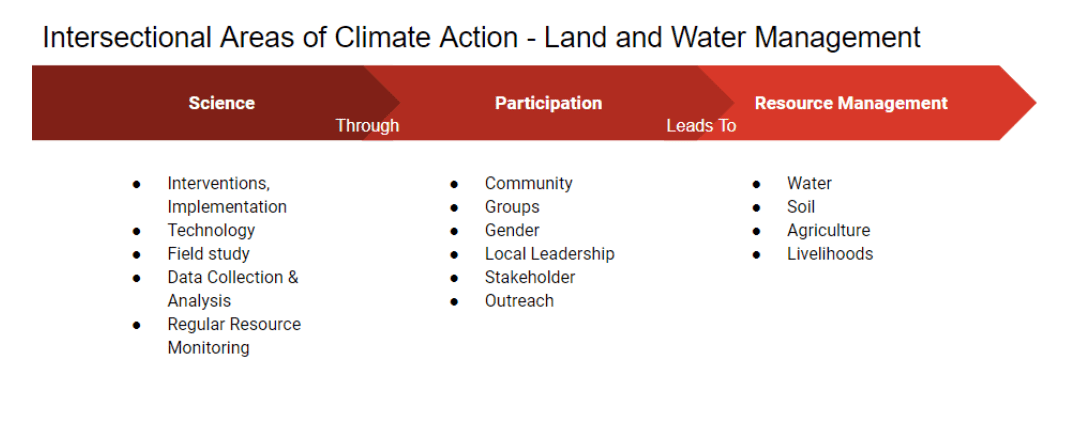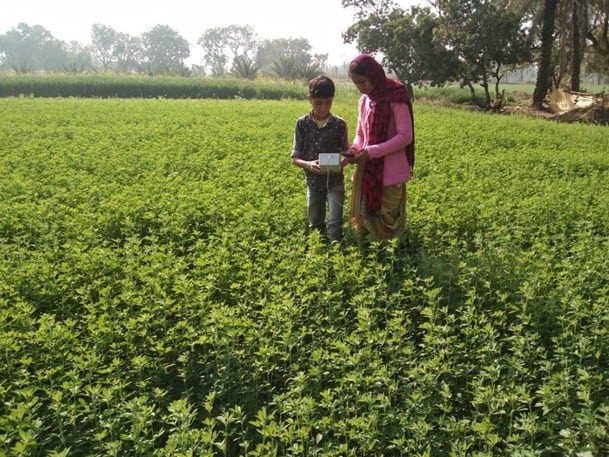Arid Communities & Technologies and WIN Foundation
Groundwater is a common pool resource, and besides the ‘tragedy of the commons’ it faces the threat of being highly exploited. Collective localised action is one of the ways to overcome the situation, and here we discuss an approach to participatory resource management work in the Kachchh district of Gujarat, India.
Kachchh is an arid region where the scanty rainfall (~380 mm) made erratic by global warming makes it ever more important to conserve water by recharging the aquifer. Agriculture accounts for nearly 90% of water consumption in India, most of it extracted from the ground. Increasing groundwater extraction is degrading and depleting it in India – where 1,114 of 6,965 assessment units (categorised as blocks/ talukas/ mandals/ watersheds) were overexploited and 97 were found saline by the Central Groundwater Board in 2020.
Soil and water give important inputs to crops, but excessive water input can increase soil salinity and degrade its quality over time. This impacts agricultural productivity, which is directly linked to the livelihood of farmers. Farmers tend to make farming decisions based on their peers’ decisions for selecting crops, seeds, products and treatments available in the market – a process often ill-informed – and there is huge scope for bridging farmers’ traditional farming methods with modern techniques to provide better yield and conserve soil, water and other resources.
The Approach

Conducting field studies and surveys, regular resource monitoring, an integrated system of data collection and analysis, impact monitoring of project interventions, introducing innovative technology and experimenting with techniques on the field form a large part of the science of our project. The ground interventions include site-specific techniques to manage aquifer recharge, perform water-saving and soil-nourishing activities in farms, monitor aquifer-wide data of groundwater level and quality, collect local weather data, and water and soil quality and soil moisture data to make informed farm-level decisions.
Local community participation is critical to ensure the sustainability of such an approach. So our project mandates encouraging local participation from groundwater user groups, women, volunteer leaders, local governance structures, and other stakeholders including academic institutes, government departments and start-ups. Sensitisation, awareness, training, skill and capacity building are crucial ways to ensure participation in sustained resource management work.
Addressing Intersectionality Through Participation
Farmers
Our core value is to ensure participation from vulnerable communities: small and marginal farmers, women and youth. From the villages, we train and build local youth capacities (with equal inclusion of women) to become para-hydrogeologists or Bhujal Jankars, who become important carriers of water and soil management knowledge and practices. Their knowledge is valued in their villages, and the respect they gain with their skills and experience in resource management is valuable as their livelihood. In order to ensure that the project benefited small and marginalised farmers, the following criteria were set:
1. They should belong to marginalised communities and have a land holding size of fewer than 5 acres.
2. Their farm could be at the tail-end of canal networks.
3. Their irrigation sources have poor water and the soil quality in their farms has been degraded.
4. The depth of the groundwater table has gone significantly low in their wells.
5. They agree to provide their voluntary participation in project interventions.
Several of training for over 200 farmers (men and women) was conducted for 19 different farming groups. Activities such as exposure visits, technology implementation, and field demonstrations were conducted. By creating partnerships with local Agriculture based organizations like Krishi Vigyan Kendra and Atma Network for Good Seeds, training around agriculture markets and practice, soil and water testing, and crop planning and advisory were conducted.
Gender
The project also increased women’s participation in groundwater management, by conducting training focused on ‘Women’s Roles and Importance of Ground Water Management’. Through the training, the project will equip participants with the knowledge to better understand gender gap issues and awareness of women’s participation and empowerment in the organisational decision-making process in natural resource management.
Some activities in the project include the creation of kitchen gardens with nutritious vegetables, the implementation of rainwater harvesting tanks, and water/soil and moisture measurements. These efforts have also resulted in an improvement in the overall health and livelihood of the younger generation. Through the education programmes, women groups are now empowered to work in village governing bodies and have shown increased confidence in expressing concerns.
Impact
In the course of 4 years, nearly 7 MCM of water has been conserved in a cluster of 19 villages in Mandvi block, Kachchh district, Gujarat – with a deficit of 32.89 MCM in 2018 reduced to 25.87 MCM in 2022. This was done through (i) several supply-side interventions such as check dams, defunct borewell recharge, tubewell recharge, riverbed filter wells and pond recharge, and (ii) demand-side activities such as soil and land management, farm bunds, changes in seed variety and irrigation methods, silt application in the farm, and irrigation based on measurements of soil moisture.
Partnerships with academic institutions, technology startups, social and startup ecosystem players and encouraging micro-entrepreneurship at the grassroots have added a multidisciplinary dimension and perspectives, adding value to the project. A centre of excellence or Bhujal Gurukul was created for knowledge sharing, under which training and capacity building was conducted for 1,759 participants (including 572 women) from various stakeholder groups. For these different stakeholder groups, the outcomes of training were different, yet relevant to their objectives:
– For groundwater user groups such as farmers and women groups, the training helped them apply knowledge to their fields, monitor agriculture data, define crop-wise water-efficient irrigation cycle, and prepare organic fertilisers, which has a direct impact on their livelihood.
– For rural youth, this training on water management and planning, and implementing water conservation structures expand their scope for job opportunities.
– Local governing bodies like panchayats benefit from the training and awareness sessions, as it helps them in village-level water management planning and convergence with other government schemes
– Formation and training of local water management institutions and committees, help in the setting protocol for the use and maintenance of harvesting structures.
Training and active participation from these different stakeholder groups help in ensuring project sustainability for years to come. Simultaneously an online skilling platform has been created, with standardised content, to allow faster online and blended training. These play an important role in scaling the work, as anchors of participatory resource management work in new project geographies.
We work in the Devbhumi Dwarka district through another such knowledge centre and have set up a new centre in the Gandhinagar district. Bhujal Jankars trained by us in the past has formed their own entrepreneurial group to offer water conservation services. We currently work with 13 Bhujal Jankars, 4 of them women, and acknowledge that more women Bhujal Jankars should be trained and are actively in the process of it.
Scalability
Across a cluster of 19 villages, more than 250 borewells are being monitored for their groundwater level and TDS data. The trend analysis maps below show changes in pre-monsoon and post-monsoon groundwater levels and TDS data. Blue regions define higher groundwater levels and lower TDS levels – Red regions show lower groundwater levels and higher TDS, in respective maps. An overall increase in blue and a decrease in red areas show improvement in groundwater status due to water conservation interventions with village community participation.

Farmers with whom we have demonstrated demand-side activities for water and soil conservation have noted a significant difference in the quality and quantity of their yield, besides resource conservation. The extensive work which was concentrated in the 19-village cluster is now expanding to more geographies (around 329 villages in 4 districts of Gujarat) through partnerships with government programs and like-minded partners.
Our approach to scaling up is to (i) create demand in farmers and other resource users – for instance, farmers need data systems to help make farm-based decisions – and (ii) enable supply to be provided by the para-workers in their villages, who provide data and basic advisory services. This helps in creating a circular economy, which is a better means of poverty alleviation.
Challenges
The results achieved in 4 years of participatory resource management concentrated in 19 villages have given a lot of learning to implement at other places. The challenges of scale lie in the quantum to be achieved in a specific time frame – because at its core, stakeholder participation needs trust, sensitisation, attitude change and skill building to achieve. To deal with this, we:
1. Showcase results achieved through our sustainable pilots,
2. Use digital tools for the skill development of the masses,
3. Develop protocols and processes to adapt our work to new locations,
4. Use centres of excellence and disseminate knowledge to all stakeholders,
5. Make use of integrated data systems for decision-making for farms at scale, and
6. Develop local leadership for sustainable resource management.

By: Arid Communities and Technologies and WIN Foundation



















